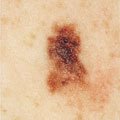I just found this site and thought I'd share one of the articles I saw listed. They have many interesting articles and information on new and break through research. Check it out! Dana Farber is one of the best cancer research institutes around!
First Targeted Therapy To Produce Remission Of Metastatic Melanoma
ScienceDaily (Apr. 17, 2008) — In a demonstration that even some of the most hard-to-treat tumors may one day succumb to therapies aimed at molecular "weak points," researchers at Dana-Farber Cancer Institute report the first instance in which metastatic melanoma has been driven into remission by a targeted therapy.
The report, published in the April 20 issue of the Journal of Clinical Oncology, describes the case of a 79-year-old woman with melanoma tumors in several parts of her abdomen. When lab tests showed the tumor cells carried an abnormality in a gene called KIT, the patient enrolled in a clinical trial involving Gleevec (R) (Imatinib), a drug known to target that gene.
Four weeks after beginning therapy, imaging exams showed a dramatic reduction in tumor size and metabolism: two of the tumor masses had disappeared and several others had shrunken considerably. Four months later, the tumors were still in check, and today, nine months after the start of therapy, she continues to take the drug and her condition remains stable.
"This is the first proof of principle that we can find an Achilles' heel in melanoma" -- a gene critical to tumor cell growth and proliferation -- "and, by targeting that gene with a drug, cause the cell to die," says the study's lead author, Stephen Hodi, MD, of Dana-Farber. "It is especially exciting because there haven't been any effective treatments for melanoma patients with metastatic disease."
Although the report involves just one patient, it should inject new confidence in the fight against melanoma, Hodi says. Because previous research has failed to find any genetic Achilles' heels capable of shutting down melanoma cell growth, some researchers had speculated that none may exist for such cells. The discovery of one suggests there may be others.
KIT mutations are found in only a small percentage of melanomas, so Imatinib does not represent a universal treatment for the disease, Hodi explains. Recent studies have found KIT mutations in 11 percent of acral melanomas (which arise in skin without hair follicles, such as that of the palms, foot soles, and nail beds, and account for 5 percent of all melanomas), 21 percent of mucosal melanomas (which arise in the mucous membranes of some organs), and 17 percent of melanomas arising in chronically sun-damaged skin. For patients with these conditions, particularly those who carry a mutation in a particular section of the gene, Imatinib may well prove beneficial.
Imatinib's effectiveness against tumors with KIT mutations was first demonstrated in gastrointestinal stromal tumors (GISTs), a relatively rare malignancy of the digestive tract. An estimated 75-80 percent of GISTs have KIT mutations, and Imatinib has caused such tumors to stabilize or retreat in 75-90 percent of patients receiving it. In most of these patients, however, tumors eventually begin growing again as they become resistant to the drug.
The KIT mutation in the patient described in the study involved a protein-coding section of the gene where DNA was duplicated. This section, known as the "juxtamembrane domain," is the most frequent site of mutation in GIST, and is associated with a strong tumor response to Imatinib.
"Dramatic remissions in metastatic melanoma are something that, as physicians, we've rarely seen," Hodi remarks. "Confirming these results will require enrolling additional patients in clinical trials -- something we're actively working to accomplish."
The senior author of the study is David E. Fisher, MD, PhD, who participated in the research as a Dana-Farber faculty member and is now at Massachusetts General Hospital. Other co-authors include Philip Friedlander, MD, PhD, Annick D. Van den Abbeele, MD, George Demetri, MD, Suzanne Mac Rae, MPH, Andrea Kruse, and Jyothi Jagannathan, MD, of Dana-Farber; Christopher Corless, MD, PhD, and Michael Heinrich, MD, of Oregon Health & Science University; and Elsa Velazquez, MD, of Brigham and Women's Hospital.
Funding for the research was provided in part by the Ron Gelb Melanoma Research Fund at Dana-Farber.
Adapted from materials provided by Dana-Farber Cancer Institute, via EurekAlert!, a service of AAAS.
Need to cite this story in your essay, paper, or report? Use one of the following formats:
APA
MLA
Dana-Farber Cancer Institute (2008, April 17). First Targeted Therapy To Produce Remission Of Metastatic Melanoma. ScienceDaily. Retrieved April 18, 2008, from http://www.sciencedaily.com? /releases/2008/04/080417211534.htm
Friday, April 18, 2008
Sunday, March 30, 2008
Melanoma and Politics

I found this article very interesting and felt I needed to share it....
John McCain’s Melanoma in Perspective
Bill Jempty | Tuesday, March 11, 2008
Senator John McCain, the presumptive Republican nominee for President, and I have a similar medical history. In a recent NY Times article, Lawrence K. Altman, M.D reported, “Mr. McCain has had four (malignant) melanomas.”
Until 2007 I was tied with the Senator. I had four of these deadly skin cancers diagnosed in 1993-94. A fifth was located on me and biopsied in 2007.
Around 150,000 a year world-wide are diagnosed with melanoma. A little under 50,000 die of the disease every year. It is the most common cancer for women under the age of 30, second most common for women age 34 and under.
Multiple melanoma survivors aren’t that common. I’ve been an active participant in MM support groups for 12 years. I can count the people I know who have had more than one of these skin cancers diagnosed. Senator McCain is the only one I know to have a total equal to mine.
In 1993, he waited more than six months before seeking care after a Navy doctor recommended that he consult a dermatologist for a lesion on his left shoulder that turned out to be his first melanoma. It was excised and has not recurred.
Pathology tests showed that the two other melanomas — detected on his upper left arm in 2000 and on his nose in 2002 — were of the least dangerous kind, in situ. In that type the malignant cells are confined to the outer layer of skin.
The most serious melanoma was spotted on his temple in 2000 by the attending physician at the United States Capitol after it had escaped the eye of Mr. McCain’s personal physician at Mayo Clinic Scottsdale. (The Capitol physician also spotted another melanoma that was in situ.)
The melanoma on Mr. McCain’s left temple was 2 centimeters in diameter and 0.22 centimeters deep, and was fully excised with wide margins, 2 centimeters in each direction, his campaign staff said.
Two of the melanomas were in situ, which are very superficial and almost never a threat after their removal. (Wikipedia says 100% survival rate. I wouldn’t go out on that limb)
Dr. Altman’s article is most concerned with the 2000 melanoma. At 0.22 depth, it is a Clark Level II. Clark Levels are used for the degree of invasion of the MM into the patient’s skin. So far as Clarks go, .22 only penetrates into the second layer of skin. Of my five melanoma, three were .26 or less. What are the survival rates for this type of melanoma?
For patients with a melanoma like Mr. McCain’s who remained free of the disease for the first five years after diagnosis, the probability of recurrence during the next five years was 14 percent and death 9 percent, a study published in 1992 found.
The melanoma is almost eight years old. In 2000 Sen. McCain had surgery to have lymph nodes removed(This resulted in noticeable puffiness and scarring on his face still seen today), they tested negative.
Any oncologist will tell you, that a MM patient is never totally free or safe from having the disease come back. The statistics in the Senator’s case are strongly in his favor.
A member of Congress, New Mexico Rep. Steven Schiff, died of melanoma in 1998.
Since the above article came from the NY Times, some have considered this another ‘hit piece’ on the Senator. Ed Morissey:
Altman then launches into an indirect criticism of McCain for not releasing his medical records yet in this campaign. He released those records early in his previous campaign, but as Altman notes, that was because they were part of a public study on the health of former POWs. Altman fails to mention that no other candidate in this race has released medical records.
The criticism isn’t indirect. The article ends saying- “Mr. McCain is occasionally asked on the campaign trail about his age. But he is almost never asked about his health.”
Professor Bainbridge writes,
The Times has taken the gloves off and is digging deep for mud to sling. Ironically, of course, McCain bashing by the Times at this point redounds to the Senator’s benefit. Lots of conservatives worried that McCain was too cozy with the liberal media. The Times is solving that problem for McCain. The people in the base who need to come around loathe the Times for its pretensions and biases. It’s the old “enemy of my enemy” story.
Even so, it’s damn shoddy journalism.
I’ve known about Sen. McCain’s melanoma history, it isn’t common knowledge to the American public. I can recall next to no mention of it in this Presidential cycle. The Times article may have been overdue. Bringing the facts out to the public about a possible future President’s health and cancer history doesn’t seem like a hit piece to me but in depth reporting instead
Subscribe to:
Posts (Atom)



